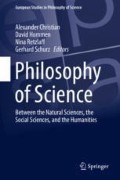Abstract
Many contemporary physicists suggest that we should take the claim that we live in a multiverse seriously. When doing this they often invoke arguments based on the controversial anthropic principle. Critics argue that this leads to untestable and unscientific theories. In this paper criteria are suggested that need to be satisfied before a multiverse theory should be considered scientifically respectable. One important point is that the multiverse is described in sufficient detail. In some cases, a multiverse theory can be testable; however, to properly test a multiverse theory it is important to distinguish new predictions from explanations based on the multiverse.
Access this chapter
Tax calculation will be finalised at checkout
Purchases are for personal use only
Notes
References
Aguirre, A. 2007. Making predictions in a multiverse. In Universe or multiverse? ed. B. Carr (2007). Cambridge: Cambridge University Press.
Barrow, J.D., and F. Tipler. 1986. The anthropic cosmological principle. Oxford: Oxford University Press.
Carr, B., ed. 2007. Universe or multiverse? Cambridge: Cambridge University Press.
Carter, B. 1974. Large number coincidences and the anthropic principle in cosmology. In Confrontation of cosmological theories with observational data, ed. Longair. M (1974). Dordrecht: D. Reidel.
Collins, R. 2007. The multiverse hypothesis: A theistic perspective. In Universe or multiverse? ed. B. Carr. Cambridge: Cambridge University Press.
Dawid, R. 2013. String theory and the scientific method. Cambridge: Cambridge University Press.
Green, M.B., J.H. Schwarz, and E. Witten. 1987. Superstring theory: 2 volumes. Cambridge: Cambridge University Press.
Greene, B. 1999. The elegant universe. London: Jonathan Cape.
———. 2004. The fabric of the cosmos: Space, time and the texture of reality. London: Allen Lane.
Hoyle, F. 1953. On the fragmentation of gas clouds into galaxies and stars. The Astrophysical Journal 118: 513.
Kachru, S., R. Kalloch, A. Linde, and S.P. Trivedi. 2003. De Sitter vacua in string theory. Physical Review D 68: 046005.
Lewis, D. 1986. On the plurality of worlds. Oxford: Basil Black well.
Linde, A. 2007. The inflationary multiverse. In Universe or multiverse? ed. B. Carr. Cambridge: Cambridge Universtiy Press.
Longair, M., ed. 1974. Confrontation of cosmological theories with observational data. Dordrecht: D. Reidel.
Page, D.N. 2007. Predictions and tests of multiverse theories. In Universe or multiverse? ed. B. Carr. Cambridge: Cambridge University Press.
Polchinski, J. 1998. String theory: 2 volumes. Cambridge: Cambridge University Press.
Schellekens, A.N. 2008. The emperors last clothes. Reports on Progress in Physics, 71, 072201. Extended version: http://arxiv.org/pdf/0807.3249v3
Smolin, L. 2006. The trouble with physics. Boston: Houghton Mifflin Company.
———. 2007. Scientific alternatives to the anthropic principle. In Universe or multiverse? ed. Carr, B (2007). Cambridge: Cambridge University Press.
Susskind, L. 2005. The cosmic landscape: String theory and the illusion of intelligent design. New York: Little, Brown and Company.
———. 2007. The anthropic landscape of string theory. In Universe or multiverse? ed. Carr, B (2007). Cambridge: Cambridge University Press.
Weinberg, S. 1987. Anthropic bound on the cosmological constant. Physical Review Letters 59: 2067.
Weinstein, S. 2006. Anthropic reasoning in multiverse and string theory. Classical and Quantum Gravity 23: 231.
Woit, P. 2006. Not even wrong. London: Jonathan Cape.
Zwiebach, B. 2004. A first course in string theory. Cambridge: Cambridge University Press.
Acknowledgments
The author would like to thank Richard Dawid and Christian Wüthrich who also contributed to the symposium on Methodological challenges in quantum gravity, which was part of the conference Philosophy of Science Between the Natural Sciences the Social Sciences and the Humanities organized by GWP and held in Düsseldorf, March 8–11, 2016.
This work was performed under a collaborative agreement between the University of Illinois at Chicago and the University of Geneva and made possible by grant number 56314 from the John Templeton Foundation and its contents are solely the responsibility of the author and do not necessarily represent the official views of the John Templeton Foundation.
Author information
Authors and Affiliations
Corresponding author
Editor information
Editors and Affiliations
Rights and permissions
Copyright information
© 2018 Springer International Publishing AG, part of Springer Nature
About this chapter
Cite this chapter
Matsubara, K. (2018). On Predictions and Explanations in Multiverse Scenarios. In: Christian, A., Hommen, D., Retzlaff, N., Schurz, G. (eds) Philosophy of Science. European Studies in Philosophy of Science, vol 9. Springer, Cham. https://doi.org/10.1007/978-3-319-72577-2_3
Download citation
DOI: https://doi.org/10.1007/978-3-319-72577-2_3
Published:
Publisher Name: Springer, Cham
Print ISBN: 978-3-319-72576-5
Online ISBN: 978-3-319-72577-2
eBook Packages: Religion and PhilosophyPhilosophy and Religion (R0)

